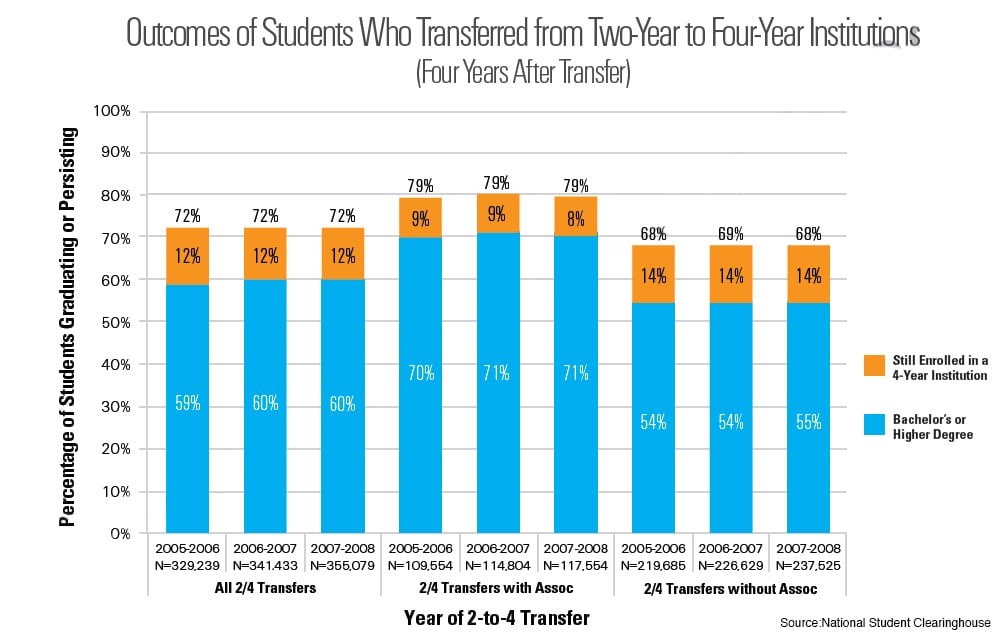You have /5 articles left.
Sign up for a free account or log in.
Only one in five community college students transfer to a four-year institution. But 60 percent of those who do so earn a bachelor’s degree within four years, according to new research from the National Student Clearinghouse Research Center. Another 12 percent are sticking with it and remain enrolled after four years.
Relatively good graduation rates for community college transfers get even better for students who complete their associate degree before heading to a four-year institution. The research found that 71 percent of those transfer students earned a bachelor degree within four years of transferring, with 80 percent either graduating or remaining enrolled.
The new statistics are novel in that they give a rare glimpse at how transfer students fare on a national level. The data also account for the “swirl” effect, which refers to the many students who transfer multiple times and move in and out of the academy, said Afet Dundar, associate director of research services at the center. That is difficult to account for even at the state level, where databases typically focus on students’ persistence at individual colleges, but lose track of them as they transfer.
“We are capturing their four-year degree wherever they received it,” Dundar said.
The National Student Clearinghouse is a nonprofit that conducts research for its 3,300 institutional members, which voluntarily turn over enrollment and degree information. Those members enroll 96 percent of the nation’s college students, and the group has been able to track cohorts of millions of students going back to 2005.
The clearinghouse’s research center has begun creating “snapshot” reports on that database. For example, in September it released a report showing that 45 percent of all students who finished a four-year degree in 2010-11 had previously enrolled at a two-year college.
This latest report breaks that research down further. But while interesting, the new information is not particularly surprising, said Davis Jenkins, a senior researcher at the Community College Research Center at Columbia University’s Teachers College. That’s because previous research has found that students who transfer from community colleges to four-year institutions generally are well-prepared for the coursework and for navigating college life.
Four-year institutions have a big incentive to “poach” community college students before they complete an associate degree, Jenkins said, with one motivation being that they want tuition revenue for general education courses. “They use the community colleges to get students ready,” he said.
Of course, with only 20 percent of community college students transferring to four-year institutions, relatively few students are getting the chance to prove themselves at the next level. Some of the students who get screened out along the way might not have made it to the finish line for a bachelor’s degree. But others could.
“It does raise the question of could we achieve these outcomes with the other 80 percent,” Jenkins said.
One way to firm up the transfer pathway is to align associate and bachelor’s degree programs, something Jenkins said many colleges don’t do well. A national example of how to do that alignment right is the partnership between Valencia College and the University of Central Florida, according to the Aspen Institute’s College Excellence Program.
An ideal scenario is for community colleges and four-year institutions to encourage students to earn an associate degree before transferring and then make sure they arrive with junior standing in a major.
“That’s the best for the college,” Jenkins said, and also “best for the state and the public.”








